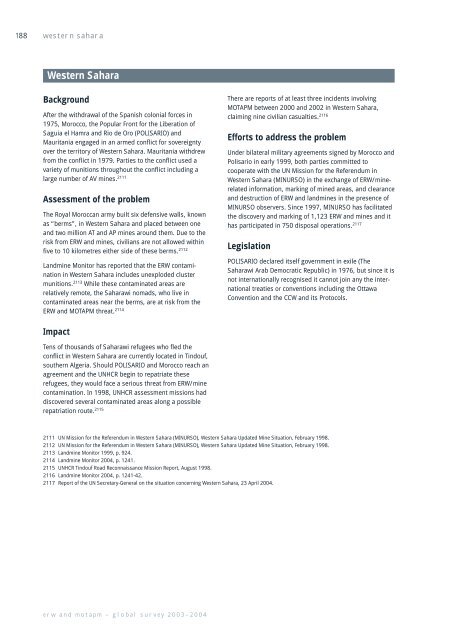Country & Territory Reports - Landmine Action
Country & Territory Reports - Landmine Action
Country & Territory Reports - Landmine Action
You also want an ePaper? Increase the reach of your titles
YUMPU automatically turns print PDFs into web optimized ePapers that Google loves.
188 western sahara<br />
Western Sahara<br />
Background<br />
After the withdrawal of the Spanish colonial forces in<br />
1975, Morocco, the Popular Front for the Liberation of<br />
Saguia el Hamra and Rio de Oro (POLISARIO) and<br />
Mauritania engaged in an armed conflict for sovereignty<br />
over the territory of Western Sahara. Mauritania withdrew<br />
from the conflict in 1979. Parties to the conflict used a<br />
variety of munitions throughout the conflict including a<br />
large number of AV mines. 2111<br />
Assessment of the problem<br />
The Royal Moroccan army built six defensive walls, known<br />
as “berms”, in Western Sahara and placed between one<br />
and two million AT and AP mines around them. Due to the<br />
risk from ERW and mines, civilians are not allowed within<br />
five to 10 kilometres either side of these berms. 2112<br />
<strong>Landmine</strong> Monitor has reported that the ERW contamination<br />
in Western Sahara includes unexploded cluster<br />
munitions. 2113 While these contaminated areas are<br />
relatively remote, the Saharawi nomads, who live in<br />
contaminated areas near the berms, are at risk from the<br />
ERW and MOTAPM threat. 2114<br />
Impact<br />
Tens of thousands of Saharawi refugees who fled the<br />
conflict in Western Sahara are currently located in Tindouf,<br />
southern Algeria. Should POLISARIO and Morocco reach an<br />
agreement and the UNHCR begin to repatriate these<br />
refugees, they would face a serious threat from ERW/mine<br />
contamination. In 1998, UNHCR assessment missions had<br />
discovered several contaminated areas along a possible<br />
repatriation route. 2115<br />
erw and motapm – global survey 2003–2004<br />
There are reports of at least three incidents involving<br />
MOTAPM between 2000 and 2002 in Western Sahara,<br />
claiming nine civilian casualties. 2116<br />
Efforts to address the problem<br />
Under bilateral military agreements signed by Morocco and<br />
Polisario in early 1999, both parties committed to<br />
cooperate with the UN Mission for the Referendum in<br />
Western Sahara (MINURSO) in the exchange of ERW/minerelated<br />
information, marking of mined areas, and clearance<br />
and destruction of ERW and landmines in the presence of<br />
MINURSO observers. Since 1997, MINURSO has facilitated<br />
the discovery and marking of 1,123 ERW and mines and it<br />
has participated in 750 disposal operations. 2117<br />
Legislation<br />
POLISARIO declared itself government in exile (The<br />
Saharawi Arab Democratic Republic) in 1976, but since it is<br />
not internationally recognised it cannot join any the international<br />
treaties or conventions including the Ottawa<br />
Convention and the CCW and its Protocols.<br />
2111 UN Mission for the Referendum in Western Sahara (MINURSO), Western Sahara Updated Mine Situation, February 1998.<br />
2112 UN Mission for the Referendum in Western Sahara (MINURSO), Western Sahara Updated Mine Situation, February 1998.<br />
2113 <strong>Landmine</strong> Monitor 1999, p. 924.<br />
2114 <strong>Landmine</strong> Monitor 2004, p. 1241.<br />
2115 UNHCR Tindouf Road Reconnaissance Mission Report, August 1998.<br />
2116 <strong>Landmine</strong> Monitor 2004, p. 1241-42.<br />
2117 Report of the UN Secretary-General on the situation concerning Western Sahara, 23 April 2004.


